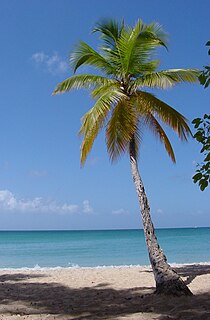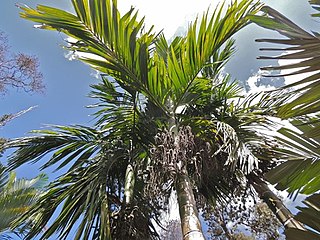
The Arecaceae is a family of perennial flowering plants in the monocot order Arecales. Their growth form can be climbers, shrubs, tree-like and stemless plants, all commonly known as palms. Those having a tree-like form are called palm trees. Currently 181 genera with around 2,600 species are known, most of them restricted to tropical and subtropical climates. Most palms are distinguished by their large, compound, evergreen leaves, known as fronds, arranged at the top of an unbranched stem. However, palms exhibit an enormous diversity in physical characteristics and inhabit nearly every type of habitat within their range, from rainforests to deserts.

The areca nut is the seed of the areca palm, which grows in much of the tropical Pacific, Southeast and South Asia, and parts of east Africa. It is commonly referred to as betel nut, not to be confused with betel leaves that are often used to wrap it. The term areca originated from the Malayalam word aḍaykka (അടയ്ക്ക) and dates from the 16th century, when Dutch and Portuguese sailors took the nut from Kerala to Europe. Consumption has many harmful effects on health and is carcinogenic to humans. Various compounds present in the nut, including arecoline, contribute to histologic changes in the oral mucosa. It is known to be a major risk factor for cancers of the mouth and esophagus. As with chewing tobacco, its use is discouraged by preventive efforts. Consumption by hundreds of millions of people worldwide – mainly with southern and eastern Asian origins – has been described as a "neglected global public health emergency".

Areca is a genus of about 50 species of palms in the family Arecaceae, found in humid tropical forests from the islands of the Philippines, Malaysia and India, across Southeast Asia to Melanesia. The generic name Areca is derived from a name used locally on the Malabar Coast of India.

Paan is a preparation combining betel leaf with areca nut widely consumed throughout Southeast Asia, South Asia and East Asia. It is chewed for its stimulant effects. After chewing, it is either spat out or swallowed. Paan has many variations. Slaked lime (chuna) paste is commonly added to bind the leaves. Some preparations in the Indian subcontinent include katha paste or mukhwas to freshen the breath.

Heart of palm is a vegetable harvested from the inner core and growing bud of certain palm trees, most notably the coconut, juçara, açaí palm, palmetto, and peach palm. Harvesting of many uncultivated or wild single-stemmed palms results in palm tree death. However, other palm species are clonal or multi-stemmed plants and moderate harvesting will not kill the entire clonal palm. Heart of palm may be eaten on its own, and often it is eaten in a salad.

Areca catechu is a species of palm which grows in much of the tropical Pacific, Asia, and parts of east Africa. The palm is believed to have originated in the Philippines, but is widespread in cultivation and is considered naturalized in southern China, Taiwan, India, Bangladesh, the Maldives, Sri Lanka, Cambodia, Laos, Thailand, Vietnam, Malaysia, Indonesia, New Guinea, many of the islands in the Pacific Ocean, and also in the West Indies.

Licuala is a genus of palms, in the tribe Trachycarpeae, commonly found in tropical forests of southern China, Southeast Asia, the Himalayas, New Guinea and the western Pacific Ocean islands.

Acanthophoenix rubra, the barbel palm, is a critically endangered palm endemic to Mauritius, Rodrigues, and La Reunion that is prized for its edible palm hearts.

Dypsis lutescens, also known as golden cane palm, areca palm, yellow palm, or butterfly palm, is a species of flowering plant in the family Arecaceae, native to Madagascar and naturalized in the Andaman Islands, Réunion, El Salvador, Cuba, Puerto Rico, the Canary Islands, southern Florida, Haiti, the Dominican Republic, Jamaica, the Leeward Islands and the Leeward Antilles.

Areca triandra, the wild areca palm, is a palm which is often used as ornamental plant. It is native to India, Bangladesh, Cambodia, Laos, Burma, Thailand, Vietnam, Malaysia, Indonesia, and the Philippines. It is also reportedly naturalized in Panama and in southern China. As a wild plant, it commonly occurs in littoral forest in Southeast Asia.
Areca andersonii is a species of flowering plant in the family Arecaceae. It is a tree endemic to Borneo. It is threatened by habitat loss.
Areca concinna is a species of flowering plant in the family Arecaceae. It is found only in Sri Lanka. It is threatened by habitat loss.
Areca glandiformis is a species of flowering plant in the family Arecaceae. It is found only in the Maluku Islands, Indonesia. It is threatened by habitat loss by increasing agriculture and forest management activities.

Areca hutchinsoniana is a species of flowering plant in the family Arecaceae. It is found only on the island of Mindanao in the Philippines.
Areca ipot, the Ipot palm, is a species of flowering plant in the family Arecaceae. It is endemic to the Philippines. It is threatened by habitat loss.
Areca parens is a species of flowering plant in the family Arecaceae. It is found only on the island of Luzon in the Philippines. It is threatened by habitat loss and listed on the IUCN Red List as Vulnerable.
Areca whitfordii is a species of flowering plant in the family Arecaceae. It is found only in the Philippines. It is threatened by habitat loss.

Bentinckia nicobarica is a species of flowering plant in the family Arecaceae found to occur in the Nicobar group of islands in the Bay of Bengal. It is an endemic palm occurring in Great Nicobar, Katchal, Nancowry and Car Nicobar Islands.
Shorea curtisii is a species of tree in the family Dipterocarpaceae. It is found in Indonesia, Malaysia, Singapore, and Thailand. It is a large tree with a grey or reddish-brown and coarsely fissured trunk; and a greyish-blue crown. It fruits every 5–10 years, after prolonged periods of drought.

Areca nut production in India is dominant in the coastal region within 400 kilometres (250 mi) from the coast line, and also in some other non-coastal states of India. Areca nut, a tropical crop, is popularly known as betel nut, as its common usage in the country is for mastication with betel leaves. It is a palm tree species under the family of Arecaceae. It has commercial and economic importance not only in India but also in China and Southeast Asia.













